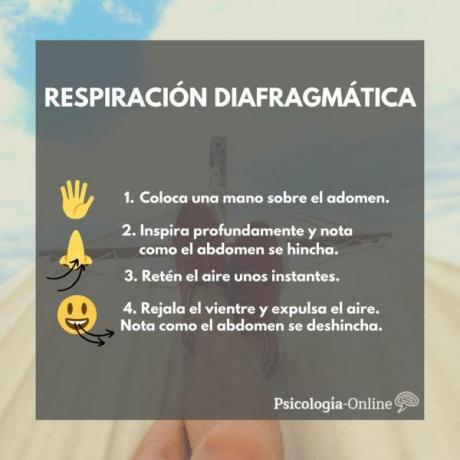
The diaphragmatic or abdominal breathing technique can be very useful for physical and mental health due to the benefits it provides. This technique serves to relax and improve oxygenation. It is not easy to do since we are very used to breathing in the thoracic way. Learning it takes practice. Therefore, in this Psychology-Online article, you will find different diaphragmatic breathing exercises explained step by step so you can train it.
Index
- What is diaphragmatic breathing
- Benefits of diaphragmatic breathing
- Diaphragmatic breathing exercises for adults
- Diaphragmatic breathing exercises for children
What is diaphragmatic breathing.
The diaphragmatic breathing, also known as abdominal breathing, is a breathing technique that consists of taking advantage of the empty space left by the abdomen as it expands forward to widen the lungs, since the diaphragm tends to go down in that direction expansion. When you release the air, the diaphragm rises again and the stomach moves inward. With this technique we achieve a even, slow, deep breathing.
The diaphragm It is a muscle located below the lungs that separates the chest from the abdomen and plays an important role in the breathing process.
As a general rule, we use chest breathing, which, as the name suggests, consists of expanding the rib cage upwards and forwards to widen the lungs while we breathe in the air. This breathing does not require concentration so we do it automatically. In contrast, diaphragmatic breathing requires our full attention, hence it provides enormous benefits in terms of concentration and relaxation.
Benefits of diaphragmatic breathing.
The most important benefits and positive effects of diaphragmatic breathing are as follows:
- Promotes relaxation and concentration because while we are doing it we focus our attention on the breathing process. That is why it is one of the strategies included in this article on how to improve concentration.
- Improves ventilation, favoring the arrival of air to the lung bases.
- Increases lung capacity, since breathing with the diaphragm the lungs expand downwards, contrary to what happens in thoracic breathing that expand upwards and forwards.
- Reduce pain.
- Decrease anxiety because slow breathing relaxes our nervous system. In a panic attack reduces activation and prevents hyperventilation that causes dizziness and blurred vision
- Improves the use of oxygen, allowing more to enter and reach all parts of the body.
- Stimulates the heart and circulation.
- Helps control recurring negative thoughts. By being focused on breathing, we put aside the worries that cause us stress.
- It has been observed that it favors intestinal transit by stimulating the large intestine.
- As we get older our lungs lose capacity. The practice of diaphragmatic breathing keeps the lungs elastic and toned.
- Helps stabilize the heart rate.
Diaphragmatic breathing exercises for adults.
Next, we will see two diaphragmatic breathing exercises so you can practice it daily. One more focused on relaxation and another only for breathing so you can do it outside the home if you need to relax or disconnect for a few minutes. Being a discreet breathing you can do it anywhere without others noticing.
1. Diaphragmatic breathing with relaxation
- Lie down comfortably and place the hand on your abdomen.
- Breathe in through your nose slow and deep while you visualize how the air enters your body and reaches everywhere.
- Hold the air inside for a count of 3.
- Now expel the air tight-lipped as you mentally repeat a mantra such as relax, calm, or whatever is comfortable and relaxing for you.
- When you have expelled the air return to count to 3 and the cycle begins again.
To increase relaxation you can use nature sounds in the background, dim lighting and even a mild smell.
2. Diaphragmatic breathing at any time
- Breathe in through your nose expanding your abdomen while you count to 5.
- Keep the air inside counting to 3.
- Let go of the air through the mouth little by little while your abdomen returns to its original position for a count of 5.
- Let them pass 3 seconds to start over.
You can do this breathing anywhere because it goes unnoticed. When you count, do it at a speed that is comfortable for you, it is not about pushing too much, but about doing it slowly and with concentration.

Diaphragmatic breathing exercises for children.
Upon entering the world, babies breathe correctly, but it seems that as they grow older they lose that ability to breathe deeply to do so in a more superficial way.
Teaching children to breathe using their abdomen can provide great benefits such as practicing attention and concentration, learn to relax and become aware of your own body and how you can control.
Children cannot use the same techniques as adults, so we are going to see some exercises to practice diaphragmatic breathing in the form of a game.
3. The giant balloon
To begin, the child should be sitting in a chair with their back against the backrest. Tell him that you are going to blow up a very, very large balloon of the color he prefers or of many colors. But you are going to do it in a special way: using your nose to catch the air instead of your mouth. As the infant begins to fill the balloon, tell him how it gets bigger and bigger to make it more real and fun.
4. The snake game
Also with the girl or boy sitting and with their back pressed against the back of the chair. In this game you have to "become a snake" and make their hiss or hiss. Ask him to take a breath through his nose, making his belly pop out and letting it go by making the snake sound (sssssss) and lengthening it as long as possible.
5. Smell the flower
You will need a flower that can be natural or plastic, or even a drawn one. The game consists of smelling the flower. Ask the boy or girl to smell the flower while they are pulling out their tummy. To release the air, you must do it through your mouth with your lips pressed towards the flower so that its perfume floods the room.
Guided relaxation video with the diaphragmatic breathing technique.
This article is merely informative, in Psychology-Online we do not have the power to make a diagnosis or recommend a treatment. We invite you to go to a psychologist to treat your particular case.
If you want to read more articles similar to Diaphragmatic breathing exercises, we recommend that you enter our category of Clinical psychology.
Bibliography
- Buela-Casal, G. Sierra, J.C. (2009). Psychological evaluation and treatment manual. Madrid: New Library.
- Martín, J; Moreno, P. (2011). Psychological Treatment of Panic Disorder and Agoraphobia: A Handbook for Therapists. Bilbao: Psychology Library.
- Mckeown, P. (2018). The Power of Oxygen: Simple, Scientifically Proven Breathing Techniques That Will Revolutionize Your Health And Fitness. Madrid: Gaia


